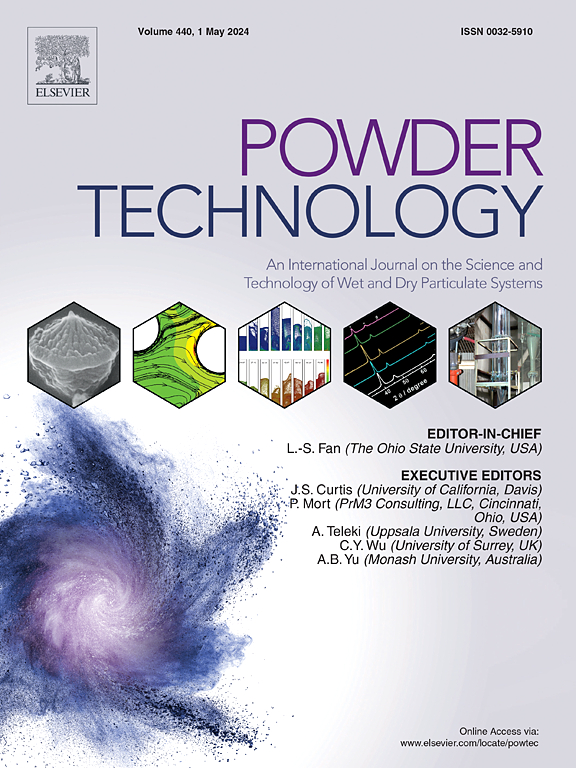"用阿拉伯树胶和分离乳清蛋白作为壁材对虾青素进行纳米封装:表征和体外释放动力学"
IF 4.5
2区 工程技术
Q2 ENGINEERING, CHEMICAL
引用次数: 0
摘要
虾青素(Astaxanthin, AST)具有抗氧化、抗肿瘤、抗炎等多种生物活性,但水溶性差、不稳定、生物可及性低等特点极大地限制了其工业应用的发展。纳米胶囊化是提高AST稳定性和生物利用度的有效方法。本研究以阿拉伯胶(GA)、乳清分离蛋白(WPI)和乳清分离蛋白/WPI复合物为壁材,研究了树突黄叶菌AST的纳米胶囊化。对纳米乳液的粘度、粒径和zeta电位进行了表征。分析了纳米包封粉末的性能、包封效率、包封率、红外光谱、热稳定性、形貌和体外释放动力学。黏度、液滴大小、zeta电位等参数在不同纳米乳液间差异显著(p≤0.05)。水分含量为3.95 ~ 6.23%,水活度为0.32 ~ 0.35,适合长期贮藏。GA/WPI-AST包封效果最好,包封效率最高(90.31%)。FTIR显示AST被很好地包裹在纳米胶囊中。DSC结果表明,包封后的AST由晶态转变为非晶态。纳米胶囊在模拟胃肠道条件下表现出控释,所有数据均与Korsmeyer-Peppas模型动力学具有良好的相关性。本文章由计算机程序翻译,如有差异,请以英文原文为准。

“Nanoencapsulation of astaxanthin using gum arabic and whey protein isolate as wall materials: Characterization and invitro release kinetics”
Astaxanthin (AST) has various biological activities, such as antioxidant, antitumor, and anti-inflammatory, but poor water solubility, instability, and low bioaccessibility greatly limit the development of its industrial application. Nanoencapsulation offers an effective method to enhance AST's stability and bioavailability. This study investigated the nanoencapsulation of AST from Xanthophyllomyces dendrorhous using gum arabic (GA), whey protein isolate (WPI), and GA/WPI complex as wall materials. The nanoemulsions were characterized for viscosity, droplet size and zeta potential. Analyses also included nanoencapsulated powder properties, encapsulation efficiency, encapsulation yield, FTIR, thermal stability, morphology and invitro release kinetics. Parameters such as viscosity, droplet size and zeta potential showed significant differences (p ≤ 0.05) among various nanoemulsions. The moisture content and water activity were in the range of 3.95–6.23 % and 0.32–0.35, respectively, which is suitable for long-term storage. The best results were achieved in GA/WPI-AST, where it had the highest encapsulation efficiency (90.31 %). FTIR revealed that the AST was well encapsulated in the nanocapsules. The results of DSC showed that the encapsulated AST changed from a crystalline state to an amorphous state. Nanocapsules displayed controlled release under simulated gastrointestinal conditions, and all the data showed good correlation with Korsmeyer-Peppas model kinetics.
求助全文
通过发布文献求助,成功后即可免费获取论文全文。
去求助
来源期刊

Powder Technology
工程技术-工程:化工
CiteScore
9.90
自引率
15.40%
发文量
1047
审稿时长
46 days
期刊介绍:
Powder Technology is an International Journal on the Science and Technology of Wet and Dry Particulate Systems. Powder Technology publishes papers on all aspects of the formation of particles and their characterisation and on the study of systems containing particulate solids. No limitation is imposed on the size of the particles, which may range from nanometre scale, as in pigments or aerosols, to that of mined or quarried materials. The following list of topics is not intended to be comprehensive, but rather to indicate typical subjects which fall within the scope of the journal's interests:
Formation and synthesis of particles by precipitation and other methods.
Modification of particles by agglomeration, coating, comminution and attrition.
Characterisation of the size, shape, surface area, pore structure and strength of particles and agglomerates (including the origins and effects of inter particle forces).
Packing, failure, flow and permeability of assemblies of particles.
Particle-particle interactions and suspension rheology.
Handling and processing operations such as slurry flow, fluidization, pneumatic conveying.
Interactions between particles and their environment, including delivery of particulate products to the body.
Applications of particle technology in production of pharmaceuticals, chemicals, foods, pigments, structural, and functional materials and in environmental and energy related matters.
For materials-oriented contributions we are looking for articles revealing the effect of particle/powder characteristics (size, morphology and composition, in that order) on material performance or functionality and, ideally, comparison to any industrial standard.
 求助内容:
求助内容: 应助结果提醒方式:
应助结果提醒方式:


